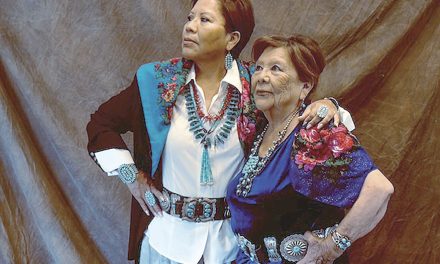
50 Years Ago: Oil companies enjoy profits leasing tribal lands

Many oilrigs, like this one, are set up near the Lybrook Ariz., area. (Times photo – Ravonelle Yazzie)
Back in 1968, oil was big news for the Navajo Times.
The paper covered anything to do with oil sales, in part because the Nakai administration as well as the BIA thought it made for good public relations.
Another factor was that the tribe was seeing big bucks throughout much of the late 50s and 60s because major oil companies were giving bonuses in the hundreds of thousands of dollars to the tribe for the leasing of tribal lands in southern Utah, northeastern Arizona and northwestern New Mexico.
Every four to six months, the BIA announced that another section of reservation land was up for leasing and then wait for the bids to come in. And they did come in because past leases had proven to be very profitable to the oil companies that won them.
This was before tribal taxation so all the oil companies had to do was pay the tribe a bonus and then a small royalty fee for every barrel of oil they removed.
In late February 1968, the BIA made one of their announcements and like the others the Navajo Times was given a two or three day head start before it was released to the off reservation papers so the paper headlined it on the front page.
The paper reported that the tribe had received a bonus of a little over $995,000 in the latest of oil negotiations. The Times’ copy editors put it down as $9 million in the front-page headline but the article had the correct figures so no harm was done.
The money was to lease 353 sections of land totaling more than 226,000 acres. This averaged out to about $8.45 cents per acre, which may not seem much today but in 1968 it was considered a good return to the tribe.
This was also an average so the tribe got less for some acres – as little as $1.06 and as high as $250 per acre in one section around Lukachukai.
In addition to the bonuses, the oil companies also agreed to pay the tribe an annual rent of $1.25 per acre.
Navajo Tribal Chairman Raymond Nakai said that much of the bonus money would be placed in the tribe’s scholarship fund to help young Navajos go to college.
The Times, in an editorial, talked about the ongoing discussion nationwide about “the new Indian,” which referred to young Navajos as well as youth from other tribes, who went forth to college to get an education so they could become part of “white society” and get the benefits from education that they could not get by raising cattle or sheep on the reservation.
The Times said that those who followed this path – and there were more of them each year – were still facing a number of problems, including drifting away from Navajo traditions that had been taught to them from an early age by their grandparents.
The Times over the next couple of months brought this subject up several more times as the articles seemed to strike a chord among many of the paper’s readers who questioned whether this was good or bad for the tribe.
In one of the articles, the paper talked to a couple of medicine men who said they didn’t think that this would result in a lot of Navajos turning their back on the traditional lifestyle. This was because it seemed that many who left the reservation for employment still managed to keep some of their traditions.
They said that many young Navajos living in places like Phoenix, Albuquerque, Los Angeles and Salt Lake City made the effort to return at Thanksgiving or Christmas. These times were big for the medicine men because many families held ceremonies then so that as many members of the family could participate as possible.
The biggest problem that the Times brought up was the possibility that many of the Navajos who moved away would marry non-Navajos and over a few generations this could become a major problem.
The paper had no evidence that this was happening and some readers wrote in saying that while it probably did happen there would be no major impact because most Navajos who live in big cities kept in touch with other Navajos so they had them available as future marriage partners.
One reader suggested that it would be in the best interest of the tribe to take steps to encourage young urban Navajos to stay in touch with their parents and grandparents. He suggested that the tribe may want to set aside some money to help low-income Navajos pay for trips back to the reservation during the holidays and possibly during the Navajo Tribal Fair.
Nothing came of this idea, however.
As for the articles about the new Indian, these seemed to be tapering off by the end of 1969 and had ended completely when Chet MacRorie became head of the Times again in 1971.
And since we brought up MacRorie, we should mention Dick Hardwick, the paper’s current editor, who enjoyed finding little tidbits and reporting them to the paper’s readers.
Someone apparently asked him about the THAT program sponsored by the Office of Navajo Economic Opportunity. In case you aren’t familiar with the program, it stood for Tribal Housing and Training.
But when he checked on how the program was named, he found out that it came from an airline stewardess who knew nothing about the reservation or ONEO.
It seemed that soon after the program was started, ONEO officials were on an airplane discussing what to call the program and the stewardess overheard them and said, “Oh, you mean THAT program?”
The officials thought it over and decided that THAT was a perfect name for the program.
To read the full article, pick up your copy of the Navajo Times at your nearest newsstand Thursday mornings!
Are you a digital subscriber? Read the most recent three weeks of stories by logging in to your online account.








 Highway 264,
Highway 264, I-40, WB @ Winslow
I-40, WB @ Winslow